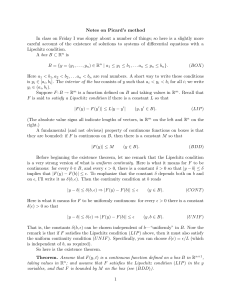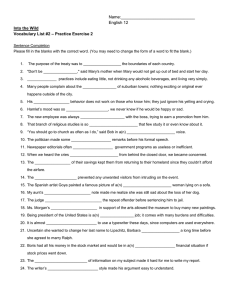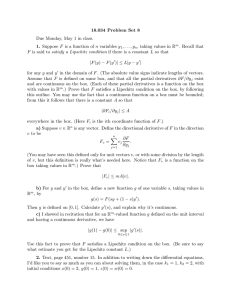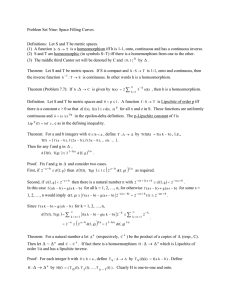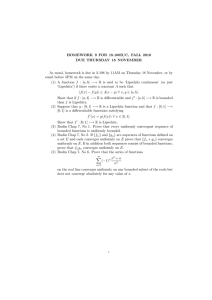DETERMINATION OF LIPSCHITZ STRATIFICATIONS FOR THE SURFACES y = z
advertisement
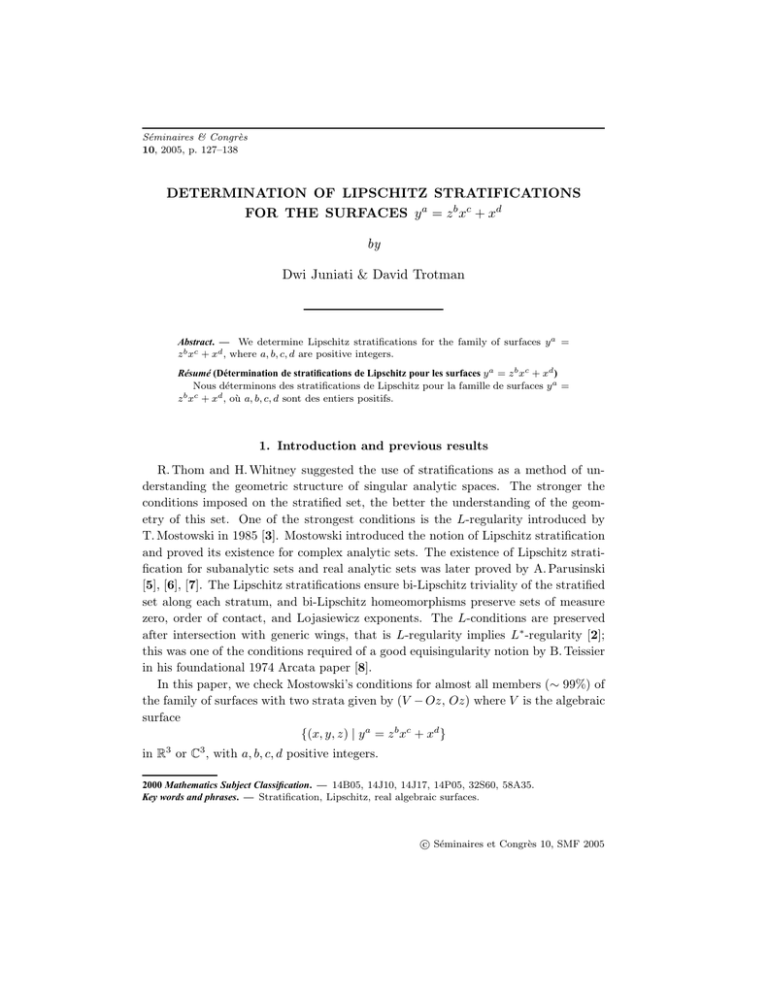
Séminaires & Congrès
10, 2005, p. 127–138
DETERMINATION OF LIPSCHITZ STRATIFICATIONS
FOR THE SURFACES y a = z b xc + xd
by
Dwi Juniati & David Trotman
Abstract. — We determine Lipschitz stratifications for the family of surfaces y a =
z b xc + xd , where a, b, c, d are positive integers.
Résumé (Détermination de stratifications de Lipschitz pour les surfaces y a = z b xc + xd )
Nous déterminons des stratifications de Lipschitz pour la famille de surfaces y a =
b
z xc + xd , où a, b, c, d sont des entiers positifs.
1. Introduction and previous results
R. Thom and H. Whitney suggested the use of stratifications as a method of understanding the geometric structure of singular analytic spaces. The stronger the
conditions imposed on the stratified set, the better the understanding of the geometry of this set. One of the strongest conditions is the L-regularity introduced by
T. Mostowski in 1985 [3]. Mostowski introduced the notion of Lipschitz stratification
and proved its existence for complex analytic sets. The existence of Lipschitz stratification for subanalytic sets and real analytic sets was later proved by A. Parusinski
[5], [6], [7]. The Lipschitz stratifications ensure bi-Lipschitz triviality of the stratified
set along each stratum, and bi-Lipschitz homeomorphisms preserve sets of measure
zero, order of contact, and Lojasiewicz exponents. The L-conditions are preserved
after intersection with generic wings, that is L-regularity implies L∗ -regularity [2];
this was one of the conditions required of a good equisingularity notion by B. Teissier
in his foundational 1974 Arcata paper [8].
In this paper, we check Mostowski’s conditions for almost all members (∼ 99%) of
the family of surfaces with two strata given by (V − Oz, Oz) where V is the algebraic
surface
{(x, y, z) | y a = z b xc + xd }
in R3 or C3 , with a, b, c, d positive integers.
2000 Mathematics Subject Classification. — 14B05, 14J10, 14J17, 14P05, 32S60, 58A35.
Key words and phrases. — Stratification, Lipschitz, real algebraic surfaces.
c Séminaires et Congrès 10, SMF 2005
D. JUNIATI & D. TROTMAN
128
The character C in this paper will stand for various constants.
We begin by recalling the definition of Lipschitz stratification due to Mostowski [3].
Let X be a closed subanalytic subset of an open subset of Rn . By a stratification
of X we shall mean a family Σ = {S j }m
j=l of closed subanalytic subsets of X defining
a filtration:
X = S m ⊃ S m−1 ⊃ · · · ⊃ S l 6= ∅
◦
and S j = S j r S j−1 , for j = l, l + 1, . . . , m (where S l−1 = ∅), is a smooth manifold of
◦
pure dimension j or empty. We call the connected components of S j the strata of Σ.
We denote the function measuring distance to S j by dj , so that dj (q) = dist(q, S j ).
Set dl−1 ≡ 1, by convention (this will be used in the definitions below).
◦
Definition 1.1. — Let γ > 1 be a fixed constant. A chain for a point q ∈ S j is a
(strictly) decreasing sequence of indices j = j1 , j2 , . . . , jr = l such that each js , s > 2,
is the greatest integer less than js−1 for which
djs −1 (q) > 2γ 2 djs (q).
◦
For each js ∈ {j1 , . . . , jr } choose a point qjs ∈ S j−s such that qj1 = q and |q − qjs | 6
γdjs (q).
If there is no confusion, we will call the sequence of points (qjs ) a chain of q.
◦
◦
For q ∈ S j , let Pq : Rn → Tq S j be the orthogonal projection to the tangent space
◦
◦
Tq S j and let Pq⊥ = I −Pq be the orthogonal projection onto the normal space (Tq S j )⊥ .
Definition 1.2. — A stratification Σ = {S j }m
j=l of X is said to be a Lipschitz stratification (or to satisfy the L-conditions) if for some constant C > 0 and for every chain
q = qj1 , qj2 , . . . , qjr and every k, 2 6 k 6 r,
|Pq⊥ Pqj2 · · · Pqjk | 6 C|q − qj2 |/djk −1 (q)
(L1)
◦
and for each q 0 ∈ S j−1 such that |q − q 0 | 6 (1/2γ)dj1 −1 (q),
(L2)
|(Pq − Pq0 )Pqj2 · · · Pqjk | 6 C|q − q 0 |/djk −1 (q)
and
|Pq − Pq0 | 6 C|q − q 0 |/dj1 −1 (q)
(L3).
2. Classifications and Calculations
In this section we give diagrams showing when L−regularity holds for the stratification with two strata given by (V − Oz, Oz) where V is the germ of the algebraic
surface
{(x, y, z) | y a = z b xc + xd }
in R3 or C3 , and a, b, c, d are positive integers.
SÉMINAIRES & CONGRÈS 10
DETERMINATION OF LIPSCHITZ STRATIFICATIONS
129
Diagrams classifying Whitney a-regularity and b-regularity for this family of algebraic surfaces were obtained by the second author ([9] and [10]), while the finer
classification needed for the Kuo-Verdier w-regularity can be found in the thesis of
L. Noirel [4].
Calculations. — It is easy to see that the (L1) condition in the definition of Lipschitz stratification of Mostowski implies the Kuo-Verdier (w) condition, and in our
case (where there are only two strata) is actually equivalent to (w). So we only need
to study cases when (w) is satisfied in the classification obtained by L. Noirel. And for
these we only need to check condition (L2) (for k = 2) and (L3). Here we illustrate
the method of obtaining the classification with details of the calculations deciding
several branches of Diagram 2 (see the end of the paper). The essential technique in
checking (L2) and (L3) is to apply the mean value theorem to compare values at the
two points q and q 0 whose distance apart is controlled.
Complete detailed calculations for the case of Lipschitz stratifications can be found
in the first author’s thesis [1].
(2.1) If a = 1, V is the graph of a smooth function, hence V is a smooth submanifold of R3 , and consequently is (L) regular.
The Lipschitz condition of Mostowski is stronger than (b)-regularity and (w)regularity, so using the classifications of Trotman in [9] and Noirel in [4] we have:
(2.2) If a 6= 1, d > c, and b is odd, the conditions (b) and (w) do not hold, and
hence the stratification is not (L) regular.
(2.3) If a 6= 1, d > c, b is even and (d − c) is odd, the conditions (b) and (w) do
not hold, and hence the stratification is not (L) regular.
(2.4) If a 6= 1, d > c, b is even, (d − c) is even and a(d − c) > b|d − a|, the condition
(w) does not hold, and hence the stratification is not (L) regular.
(2.5) If a 6= 1, d > c, b is even, (d − c) is even, a(d − c) 6 b|d − a|, and c < a 6 d,
the conditions (b) and (w) do not hold, and hence the stratification is not (L) regular.
Notation. — Let f and g be two real valued functions defined on the same set. We
will write f g if there exists a function α which tends to 0 at 0, such that f 6 αg.
We also will write f ≈ g if there is a positive constant C such that f 6 Cg and
g 6 Cf . For functions defined on R3 , we will use this notation for their restrictions
to V .
Proposition 2.1. — Consider the stratification with two strata (V − Oz, Oz) of the
germ V = {(x, y, z) | y a = z b xc + xd } in R3 , where a, b, c, d are positive integers.
Suppose c > d. Then the stratification is Lipschitz.
Proof. — Let V = {(x, y, z) | f (x, y, z) = −y a + z b xc + xd }, so that Sing V = Oz.
SOCIÉTÉ MATHÉMATIQUE DE FRANCE 2005
D. JUNIATI & D. TROTMAN
130
Let (q, qj2 ) be a chain, with q = (x, y, z) ∈ Reg V and qj2 ∈ Oz . We shall write ∂q f
for the gradient of f at q from now on.
Then
∂q f = (cxc−1 z b + dxd−1 , −ay a−1 , bxc z b−1 ).
Then dj2 −1 (q) = 1, and dj1 −1 (q) = d(q, Oz ). By the definition of orthogonal projection, we have the following inequalities:
|Pq − Pq0 | = |Pq⊥ − Pq⊥0 |,
D
∂q f E ∂q f
and Pq⊥ (v) = v,
.
k∂q f k k∂q f k
Suppose c > d. In this case (w)-regularity holds, so that to verify that the stratification is Lipschitz it is enough to check (L2) and (L3) in the definition of Lipschitz
stratification, because for a stratification composed of two strata, (w) is equivalent
to (L1).
We work in a neighbourhood of the origin. By definition of V , we have y =
d
1/a
±xd/a (z b xc−d + 1)
and we see that y ≈ xs a .
I. Case a < d. — We have that y ≈ xd/a and a < d, hence |y| = ◦|x| and d(q, Oz ) ≈
|x|. Take q 0 = (x0 , y 0 , z 0 ) ∈ V − Oz, such that |q − q 0 | 6 12 d(q, Oz ). That is:
|q − q 0 | =
p
1
(x − x0 )2 + (y − y 0 )2 + (z − z 0 )2 6 |x|.
2
It is easy to see that xx0 > 0. We shall treat separately the cases yy 0 < 0 and yy 0 > 0.
If yy 0 < 0, then as xx0 > 0, it follows that |y| + |y 0 | 6 C|q − q 0 |. For a point
q = (x, y, z), we have:
∂f = |cxc−1 z b + dxd−1 | ≈ |xd−1 | because c > d
∂x
∂f = |ay a−1 | ≈ |xd−d/a |
∂y
∂f = |bxc z b−1 |.
∂z
As a < d, in some neighbourhood of 0 we have:
∂f ∂f ∂x
∂y
∂f ∂f and .
∂z
∂y
Calculating,
bxc z b−1 ∂ f bxc z b−1 (cxc−1 z b + dxd−1 , −ay a−1 , bxc z b−1 ) q =
k∂q f k2
(cxc−1 z b + dxd−1 )2 + (−ay a−1 )2 + (bxc z b−1 )2
xc z b−1 ≈ a−1 y
SÉMINAIRES & CONGRÈS 10
DETERMINATION OF LIPSCHITZ STRATIFICATIONS
131
since ∂f /∂x ∂f /∂y and ∂f /∂z ∂f /∂y in some neighbourhood of 0, and
xc z b−1 xc z b−1 xc z b−1 <
a−1 = b c
y
y
z x + xd
xd
≈ xc−d z b−1 < 1 in some neighbourhood of 0.
Then
(Pq − Pq0 )Pqj2 = (Pq − Pq0 )(0, 0, 1) = (Pq⊥ − Pq⊥0 )(0, 0, 1)
c b−1
bxc z b−1 ∂ f
bx0 z 0 ∂q0 f q
−
=
k∂q f k2
k∂q0 f k2
6 |y| + |y 0 | < C|q − q 0 |.
We have shown that (L2) holds when yy 0 < 0.
Now we check (L3) when yy 0 < 0. Take the basis vectors: (1, 0, 0), (0, 1, 0) and
(0, 0, 1). Calculating:
(cxc−1 z b + dxd−1 )∂ f (cxc−1 z b + dxd−1 )(cxc−1 z b + dxd−1 , −ay a−1 , bxc z b−1 ) q =
k∂q f k2
(cxc−1 z b + dxd−1 )2 + (−ay a−1 )2 + (bxc z b−1 )2
cxc−1 z b + dxd−1 ≈
y a−1
since ∂f /∂x ∂f /∂y and ∂f /∂z ∂f /∂y in some neighbourhood of 0, and
cxc−1 z b + dxd−1 |x|
is bounded in some neighbourhood of 0.
ay a−1
|y|
Hence
(Pq − Pq0 )(1, 0, 0) = (Pq⊥ − Pq⊥0 )(1, 0, 0)
d−1
c−1 b
(cxc−1 z b + dxd−1 )∂ f
)∂q0 f (cx0 z 0 + dx0
q
=
−
k∂q f k2
k∂q0 f k2
y y0 |q − q 0 |
.
6 + 0 6 C
x
x
d(q, Oz )
We
do the same for
the basis vector (0, 1, 0). Because ∂f /∂x ∂f /∂y and
∂f /∂z ∂f /∂y in a neighbourhood of 0,
ay a−1 ∂ f (y a−1 )2
q |.
≈
k∂q f k2
k∂q f k2
(i)
Also
|(Pq − Pq0 )(0, 1, 0)| = |(Pq⊥ − Pq⊥0 )(0, 1, 0)|
a−1
ay a−1 ∂ f
ay 0
∂q0 f q
=
−
.
k∂q f k2
k∂q0 f k2
SOCIÉTÉ MATHÉMATIQUE DE FRANCE 2005
D. JUNIATI & D. TROTMAN
132
Note that the majoration of the x-coordinate of the vector in the line above has already
been done in the calculation for (1, 0, 0). The majoration for the z-coordinate has also
been done above in checking (L2). So we just need to consider the y-coordinate:
(y a−1 )(y a−1 ) ((y 0 )a−1 )((y 0 )a−1 ) −
.
k∂q f k2
k∂q0 f k2
Let
(y a−1 )2
.
k∂q f k2
Then it suffices to show that α is Lipschitz. Calculation shows that:
α=
x
∂α
,
∂x
x
∂α
,
∂y
and
x
∂α
∂z
are bounded in a neighbourhood of 0, and we can apply the mean value theorem to
show there exists a constant C such that:
|q − q 0 |
.
(ii)
|(Pq − Pq0 )(0, 1, 0)| 6 C
d(q, Oz )
By (i) and (ii) we can conclude that (L3) holds when yy 0 < 0.
Now let yy 0 > 0 and xx0 > 0 (q and q 0 are in a connected set). We shall check
(L2):
|(Pq − Pq0 )Pqj2 | = |(Pq − Pq0 )(0, 0, 1)| = |(ξ1 , ξ2 , ξ3 )|
with ξi = gi (q) − gi (q 0 ), where gi : R3 → R, q 7→ gi (q), and
g1 =
∂f /∂z · ∂f /∂x
k∂q f k
2
,
g2 =
∂f /∂z · ∂f /∂y
2
k∂q f k
,
g3 =
(∂f /∂z)2
2
k∂q f k
.
It is not hard to show that ∂gi /∂x, ∂gi /∂y and ∂gi /∂z are bounded in some neighbourhood of 0, for i = 1, 2, 3.
Note that q and q 0 can be joined by a curve of length comparable to |q − q 0 |. Then
we can apply the mean value theorem, and say there exists a constant Ci such that
|ξi | 6 Ci |q − q 0 |, ∀ i = 1, 2, 3.
We conclude that there exists a constant C > 0 such that |(Pq −Pq0 )Pqj2 | 6 C|q−q 0 |,
i.e. condition (L2) holds when yy 0 > 0.
To check condition (L3) when yy 0 > 0, we use basis vectors v1 = (1, 0, 0), and
v2 = (0, 1, 0).
For v1 = (1, 0, 0), we have:
∂f ∂f ∂f ∂f
∂f ∂f ∂f ∂f ∂x ( ∂x , ∂y , ∂z )
∂x0 ( ∂x0 , ∂y 0 , ∂z 0 ) |(Pq − Pq0 )(v1 )| = −
.
k∂q f k2
k∂q0 f k2
Let
m1 =
(∂f /∂x)2
k∂q f k2
,
SÉMINAIRES & CONGRÈS 10
m2 =
∂f /∂x · ∂f /∂y
k∂q f k2
,
and m3 =
∂f /∂x · ∂f /∂z
k∂q f k2
.
DETERMINATION OF LIPSCHITZ STRATIFICATIONS
133
Calculating, we can show that:
∂mi
∂mi
∂mi
, x
, and x
∂x
∂y
∂z
are bounded in some neighbourhood of 0, for i = 1, 2, 3.
Then we can apply the mean value theorem to show there exists a constant C such
that:
|q − q 0 |
(1)
|(Pq − Pq0 )(v1 )| 6 C
.
d(q, Oz )
x
For v2 = (0, 1, 0), we have:
∂f ∂f ∂f ∂f
∂y ( ∂x , ∂y , ∂z )
−
|(Pq − Pq0 )(v2 )| = 2
k∂q f k
Let
n1 =
∂f /∂y · ∂f /∂x
2
k∂q f k
,
n2 =
(∂f /∂y)2
2
k∂q f k
,
∂f ∂f ∂f ∂f ∂y 0 ( ∂x0 , ∂y 0 , ∂z 0 ) 2
.
k∂q0 f k
and n3 =
∂f /∂y · ∂f /∂z
2
k∂q f k
.
It is easy to show that:
∂ni
∂ni
∂ni
, x
,
and x
∂x
∂y
∂z
are bounded in some neighbourhood of 0, for i = 1, 2, 3.
Then we can apply the mean value theorem to show there exists a constant C such
that:
|q − q 0 |
(2)
|(Pq − Pq0 )(v2 )| 6 C
.
d(q, Oz )
x
By (1) and (2) we see that (L3) holds when yy 0 > 0.
II. Case a > d. — Supposing that y ≈ xd/a and a > d, then |x| = ◦|y| or |x| ≈ |y|,
and d(q, Oz ) ≈ |y|.
Let q 0 = (x0 , y 0 , z 0 ) ∈ Reg V , such that |q − q 0 | 6 21 d(q, Oz ). This means that:
p
1
|q − q 0 | = (x − x0 )2 + (y − y 0 )2 + (z − z 0 )2 6 |y|.
2
It is easy to see that yy 0 > 0, and that |x| < |q − q 0 | and |x0 | < |q − q 0 |. We shall treat
separately the cases xx0 < 0 and xx0 > 0.
First let xx0 < 0, and yy 0 > 0, then |x| + |x0 | 6 C|q − q 0 |. For a point q = (x, y, z),
we have:
∂f = |cxc−1 z b + dxd−1 | ≈ |xd−1 | because c > d
∂x
∂f = |ay a−1 | ≈ |(z b xc + xd )(a−1)/a | ≈ |xd−d/a |
∂y
∂f = |bxc z b−1 |.
∂z
SOCIÉTÉ MATHÉMATIQUE DE FRANCE 2005
D. JUNIATI & D. TROTMAN
134
If a > d, then in some neighbourhood of 0 we have:
∂f ∂f ∂f ∂f and | ,
∂y
∂x
∂z
∂x
while if a = d, then
∂f ∂f ∂f ∂f ≈ and | .
∂y
∂x
∂z
∂x
Using the same method as in the case when a < d, we can show that the L
conditions hold.
In the case when xx0 > 0, and yy 0 > 0, we can use the mean value theorem and
the same method as for a < d, to check that the L conditions hold. This completes
the proof of the Proposition.
Proposition 2.2. — Let two strata be given by (V − Oz, Oz) where the germ V =
{(x, y, z) | y a = z b xc +xd } in R3 , and a, b, c, d are positive integers. Suppose a(d−c) 6
b |d − a|. The condition (L2) in the definition of Lipschitz stratification is not satisfied
in the cases below:
(1)
(2)
(3)
(4)
c < d < a, and d, c are even,
c < d < a, and b < 2(d − c),
c < d, a < d, and a is even,
a 6 c < d, and 2a(d − c) > db.
Proof. — Let V = {(x, y, z) | f (x, y, z) = −y a + z b xc + xd }, so Sing V ⊂ Oz.
Case (1). Let q = (t, 21/a td/a , t(d−c)/b ), q 0 = (−t, 21/a td/a , t(d−c)/b ), and qj2 =
(0, 0, t(d−c)/b ), for positive t near 0. We have:
p
|q − q 0 | = 2t and dj1 −1 (q) = d(q, Oz ) = t2 + t2d/a .
Then there is γ > 1 such that |q − q 0 | 6
1
2γ dj1 −1 (q),
because d < a. Now,
∂q f = (cxc−1 z b + dxd−1 , −ay a−1 , bxc z b−1 ),
Also dj2 −1 (q) = 1, |Pq − Pq0 | = |Pq⊥ − Pq⊥0 |, and Pq⊥ (v) = v, ∂q f /k∂q f k ∂q f /k∂q f k.
Then
|(Pq − Pq0 )Pqj2 (v)| = |(Pq − Pq0 )(0, 0, 1)| = |(Pq⊥ − Pq⊥0 )(0, 0, 1)|
c b−1
bxc z b−1 ∂ f
bx0 z 0 ∂q0 f q
−
=
k∂q f k2
k∂q0 f k2
td−(d−c)/b td−d−c/b td−1
≈ d−1 2
≈
.
td−1
(t ) + (td−d/a )2 + (t(d−(d−c)/b )2
We have |(Pq − Pq0 )Pqj2 | ≈ t1−(d−c)/b and |q − q 0 |/dj2 −1 (q) ≈ t, so (L2) fails.
Case (2). Let q = (t, 21/a td/a , t(d−c)/b ), q 0 = (t, 21/a td/a , −t(d−c)/b ), and qj2 =
(0, 0, t(d−c)/b ), for positive t near 0. With the same technique as above we have
that |(Pq − Pq0 )Pqj2 | ≈ t1−(d−c)/b and |q − q 0 |/dj2 −1 (q) ≈ t(d−c)/b , and by hypothesis
b < 2(d − c) so (L2) fails.
SÉMINAIRES & CONGRÈS 10
DETERMINATION OF LIPSCHITZ STRATIFICATIONS
135
Case (3). Let q = (t, 21/a td/a , t(d−c)/b ), q 0 = (t, −21/a td/a , t(d−c)/b ), and qj2 =
(0, 0, t(d−c)/b ), for positive t near 0. With the same technique as above we have
|(Pq − Pq0 )Pqj2 | ≈ td/a−(d−c)/b and |q − q 0 |/dj2 −1 (q) ≈ td/a , and by hypothesis d/a −
(d − c)/b < d/a so (L2) fails.
Case (4). Let q = (t, 21/a td/a , t(d−c)/b ), q 0 = (t, 21/a td/a , −t(d−c)/b ), and qj2 =
(0, 0, t(d−c)/b ), for positive t near 0. With the same technique as above we have
|(Pq − Pq0 )Pqj2 | ≈ td/a−(d−c)/b and |q − q 0 |/dj2 −1 (q) ≈ t(d−c)/b , and by hypothesis
2a(d − c) > db so (L2) fails. This completes the proof of the Proposition.
Now we determine when the stratification is Lipschitz supposing that d > c, b and
d − c are even, and that a is odd, a > 3. To ensure that (L1) holds (i.e. (w)) we need
that a(d − c) 6 b|d − a|.
We can replace the equation y a = z b xc + xd by y = (z b xc + xd )1/a to simplify the
calculation. Let φ(x; z) = y − (xc z b + xd )1/a . Then V = {(x, y, z) | φ(x, y, z) = 0}.
∂ϕ ∂ϕ
∂ϕ ∂ϕ ∂ϕ
0
Let q = (x, y, z) and q 0 = (x0 , y 0 , z 0 ), so ∂q ϕ = ( ∂ϕ
∂x , ∂y , ∂z ), and ∂q ϕ = ( ∂x0 , ∂y 0 , ∂z 0 ).
We know that dj2 −1 (q) = 1. Then
∂ϕ ∂ϕ ∂ϕ ∂ϕ
∂ϕ ∂ϕ ∂ϕ ∂ϕ ∂z ( ∂x , ∂y , ∂z )
∂z 0 ( ∂x0 , ∂y 0 , ∂z 0 ) −
|(Pq − Pq0 )Pqj2 | = 2
2
.
k∂q ϕk
k∂q0 ϕk
2
2
2
Let h1 = ∂ϕ/∂z · ∂ϕ/∂x/k∂q ϕk , h2 = ∂ϕ/∂z/k∂q ϕk , and h3 = (∂ϕ/∂z)2 /k∂q ϕk .
If ∂h1 /∂x and ∂h1 /∂z are bounded near 0, then by using the mean value theorem,
there is a constant C for q, q 0 near 0, such that:
∂ϕ/∂z · ∂ϕ/∂x ∂ϕ/∂z 0 · ∂ϕ/∂x0 6 C|q − q 0 |.
−
k∂q ϕk2
k∂q0 ϕk2
Similarly for h2 and h3 , if ∂h2 /∂x, ∂h2 /∂z, ∂h3 /∂x, ∂h3 /∂z, are bounded near 0,
then there is a constant C such that:
(∂ϕ/∂z)2
∂ϕ/∂z
∂ϕ/∂z 0 (∂ϕ/∂z 0 )2 0
6
C|q
−
q
|,
and
6 C|q − q 0 |.
−
−
2
2
k∂ ϕk2
k∂ ϕk2
k∂ 0 ϕk k∂ 0 ϕk q
q
q
q
This means that there exists a constant C, such that for q and q 0 near 0, we have:
|(Pq − Pq0 )Pqj2 | 6 C|q − q 0 |
(L2).
To verify the (L3) condition in the definition of Lipschitz stratification, we use
the vector basis v1 = (1, 0, 0), v2 = (0, 1, 0), and v3 = (0, 0, 1). If c > a, dj1 −1 =
d(q, Oz) ≈ x. For v1 = (1, 0, 0), we have:
∂ϕ ∂ϕ ∂ϕ ∂ϕ
∂ϕ ∂ϕ ∂ϕ ∂ϕ ∂x ( ∂x , ∂y , ∂z )
∂x0 ( ∂x0 , ∂y 0 , ∂z 0 ) |(Pq − Pq0 )(v1 )| = −
.
k∂q ϕk2
k∂q0 ϕk2
Let k1 = (∂ϕ/∂x)2 /k∂q ϕk2 , k2 = ∂ϕ/∂x/k∂q ϕk2 , and k3 = ∂ϕ/∂x · ∂ϕ/∂z/k∂q ϕk2 .
If x∂k1 /∂x, and x∂k1 /∂z are bounded near 0, by using the mean value theorem,
there is a constant C such that for q, q 0 near 0:
(∂ϕ/∂x)2
|q − q 0 |
(∂ϕ/∂x0 )2 −
.
2 6 Cd
k∂ ϕk2
j −1 (q)
k∂ 0 ϕk
q
q
1
SOCIÉTÉ MATHÉMATIQUE DE FRANCE 2005
D. JUNIATI & D. TROTMAN
136
Similarly with k2 and k3 , if x∂k2 /∂x, x∂k2 /∂z, x∂k3 /∂x, x∂k3 /∂z, are bounded
near 0, then there is a constant C such that:
∂ϕ ∂ϕ
∂ϕ
∂ϕ ∂ϕ/∂x
∂x · ∂z
∂ϕ/∂x0 |q − q 0 |
|q − q 0 |
∂x0 · ∂z 0 −
−
and
.
6
C
6
C
2
2
k∂ ϕk2
k∂ ϕk2
dj1 −1 (q)
dj1 −1 (q)
k∂q0 ϕk k∂q0 ϕk q
q
This means that there exists a constant C, such that for q and q 0 near 0, we have:
|q − q 0 |
(L3)(i)
|(Pq − Pq0 )(v1 )| 6 C
.
dj1 −1 (q)
For v2 = (0, 1, 0), we have:
∂ϕ ∂ϕ ∂ϕ ∂ϕ
∂y ( ∂x , ∂y , ∂z )
−
|(Pq − Pq0 )(v2 )| = 2
k∂q ϕk
∂ϕ ∂ϕ ∂ϕ ∂ϕ ∂y 0 ( ∂x0 , ∂y 0 , ∂z 0 ) 2
.
k∂q0 ϕk
It is clear that if (L2) and (L3)(i) are verified, then we have
|(Pq − Pq0 )(v2 )| 6 C
(L3)(ii)
|q − q 0 |
.
dj1 −1 (q)
For v3 = (0, 0, 1), we have:
∂ϕ ∂ϕ ∂ϕ ∂ϕ
∂z ( ∂x , ∂y , ∂z )
−
|(Pq − Pq0 )(v3 )| = 2
k∂q ϕk
It is clear that if (L2) is verified, then we have
(L3)(iii)
|(Pq − Pq0 )(v3 )| 6 C
∂ϕ ∂ϕ ∂ϕ ∂ϕ ∂z 0 ( ∂x0 , ∂y 0 , ∂z 0 ) 2
.
k∂q0 ϕk
|q − q 0 |
.
dj1 −1 (q)
By calculation of differentials, we find that if ∂ϕ/∂x, ∂ϕ/∂z, ∂ 2 ϕ/∂x∂z, and ∂ 2 ϕ/∂z 2
are bounded near 0, then
∂k2
∂k2
∂k3
∂k3
∂k1
∂h1
∂k2
∂k2
∂k3
∂k3
∂h1 ∂h1
,
, x
, x
, x
, x
, x
, x
, x
, x
, x
, x
,
∂x ∂z
∂x
∂z
∂x
∂z
∂x
∂z
∂x
∂z
∂x
∂z
are all bounded near 0. And we have that:
•
•
•
•
∂ϕ/∂x is bounded if c > a, d > a,
∂ϕ/∂z is bounded if b > a, or if a(d − c) 6 d,
∂ 2 ϕ/∂z 2 is bounded if b > 2a, or if 2a(d − c) 6 d,
∂ 2 ϕ/∂x∂z is bounded if b > a, c > a or if 2a(d − c) 6 d − a.
In the complex case, if a = 1 the L-conditions hold, while if a > 1 and d > c,
Whitney’s condition (b) is not satisfied ([9], [10]), and so the L-conditions fail. When
d 6 c, we can prove that the L-conditions are satisfied by the mean value theorem.
Acknowledgements. — We are grateful to the referee for pertinent comments on a
previous version of this paper. We also thank Claudio Murolo and Guillaume Valette
for help with the preparation of the manuscript.
SÉMINAIRES & CONGRÈS 10
DETERMINATION OF LIPSCHITZ STRATIFICATIONS
137
√
Figure 1. L−regularity in R3 . Note:
means that regularity holds, ×
means that regularity fails, b ≡ 0(2) means that b is even, etc.
SOCIÉTÉ MATHÉMATIQUE DE FRANCE 2005
138
D. JUNIATI & D. TROTMAN
References
[1] D. Juniati – De la régularité Lipschitz des espaces stratifiés, thèse, Université de
Provence, 2002.
[2] D. Juniati, D. Trotman & G. Valette – Lipschitz stratifications and generic wings,
J. London Math. Soc. (2) 68 (2003), p. 133–147.
[3] T. Mostowski – Lipschitz equisingularity, Dissertationes Math., vol. 243, PWN, Warsaw, 1985.
[4] L. Noirel – Plongements sous-analytiques d’espaces stratifies de Thom-Mather, thèse,
Université de Provence, 1996.
[5] A. Parusinski – Lipschitz properties of semi-analytic sets, Ann. Inst. Fourier (Grenoble) 38 (1988), p. 189–213.
[6]
, Lipschitz stratification of real analytic sets, in Singularities (S. Lojasiewicz,
ed.), Banach Center publications, vol. 20, PWN, Warsaw, 1988, p. 323–333.
[7]
, Lipschitz stratification of subanalytic sets, Ann. scient. Éc. Norm. Sup. 4e série
27 (1994), no. 6, p. 661–696.
[8] B. Teissier – Introduction to equisingularity problems, in Algebraic Geometry Symposium (Arcata, 1974), American Mathematical Society, Providence, RI, 1975, p. 593–632.
[9] D. Trotman – Whitney stratifications : faults and detectors, Ph.D. Thesis, Warwick,
1977.
, On the canonical Whitney stratifications of algebraic hypersurface, in Séminaire
[10]
sur la géométrie algébrique réelle (J.-J. Risler, ed.), Publ. Math., vol. 24, Univ. Paris
VII, Paris, 1987, p. 123–152.
D. Juniati, Laboratoire d’Analyse, Topologie et Probabilités, UMR 6632 du CNRS, Université de
Provence, 39 rue Joliot-Curie, 13453 Marseille, France • Dept. of Mathematics, Faculty
of Natural Sciences, Universitas Negeri Surabaya (UNESA), Indonesia
E-mail : dwi_juniati@yahoo.com
D. Trotman, Laboratoire d’Analyse, Topologie et Probabilités, UMR 6632 du CNRS, Université
de Provence, 39 rue Joliot-Curie, 13453 Marseille, France • E-mail : trotman@cmi.univmrs.fr
SÉMINAIRES & CONGRÈS 10

